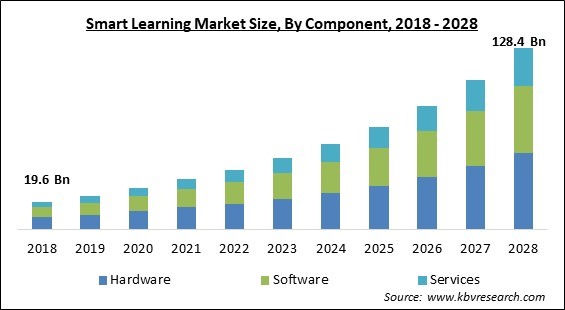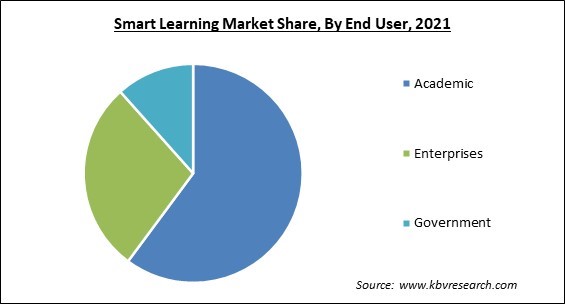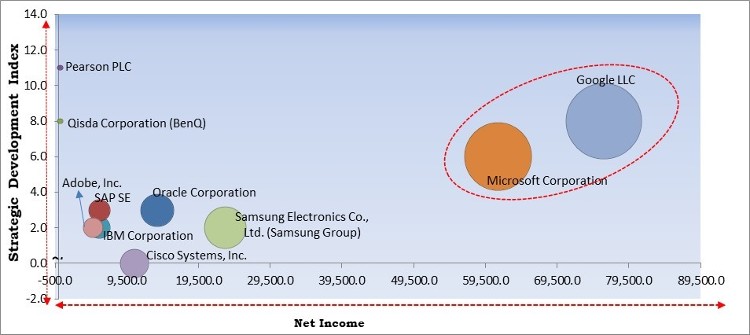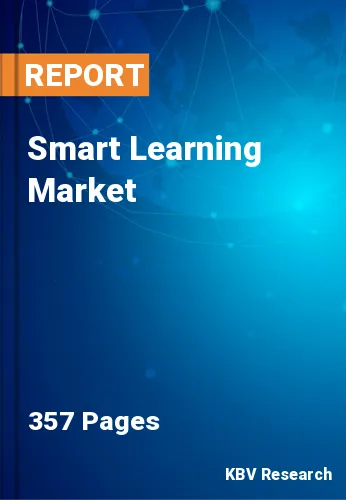The Global Smart Learning Market size is expected to reach $128.4 billion by 2028, rising at a market growth of 20.3% CAGR during the forecast period.
Smart learning is a broad word for education that complies with the requirements of the modern era. It demonstrates how sophisticated technologies enable learners to absorb knowledge and skills in a more effective, efficient, and easy manner. The current global drive toward smart learning represents a significant paradigm shift in educational landscape. Smart learning intends to provide students with a complete education through the use of current technologies in order to properly prepare them for a rapidly evolving environment in which adaptability is essential. Smart education is a learning approach that has been tailored to the needs of current generations of digital natives. In addition, smart education, in contrast to conventional classroom teaching techniques, is an interactive, collaborative, and visual paradigm that aims to boost student engagement and allow teachers to adapt to students' talents, interests, and learning preferences.
A student can easily interact with classmates from all over the world using modern learning methods. Students can communicate with each other on virtual various learning platforms, participate in online discussion threads to get answers to their questions, and attend Massive Online Open Courses (MOOC) from the world's leading universities at anytime from anywhere. They can also compare themselves to other students in their subject to evaluate if their learning outcomes are acceptable by international standards. In the development of smart cities, smart education is a critical component. A smart city has strengths in fundamental education, advanced certification and training, community and universities colleges, e-learning infrastructures, lifelong learning, and educational technology innovation. To ensure that the people of a smart city rapidly develop, smart education is a necessary aspect.
The utilization of tools and equal engagement of teachers and students distinguishes traditional teaching methodologies from new-age smart learning education. Teachers collaborate with their students through online learning tools and approach in a smart learning education system, which aims to develop quick learning skills among students. Online displays, games, puzzles, and other tough programs engage brain cells to constantly process the input, resulting in a fresh perspective.

The COVID-19 outbreak caused a significant downfall to various economies all over the world. The outbreak of the novel coronavirus slowed down numerous businesses globally. In addition, due to the rapid spread of the infection, governments all over the world were forced to impose countrywide lockdowns. Due to the travel restrictions under the lockdown, the supply chain of various goods, as well as intermediate goods, was significantly disrupted. The smart learning market observed a significant growth during the pandemic. All of the schools and other educational institutes were shut as a result of the rapidly rising corona cases as well as the worldwide lockdown.
Unlike the old learning method, which required students to take extensive written notes. Students may create presentations online and receive feedback from their instructors and teachers in a very short period of time due to smart classroom technology. Teachers do not require to provide rough notes to their students because the presentation can be shared with everyone directly. This saves a lot of time for teachers and students that could be spent on another interactive activity. Due to the requirement of a lesser period of time, smart learning can significantly increase the productivity of teachers as well as students.
As technology advances, there is an increasing demand for smart learning solutions in order to improve the learning experience. Visual features such as graphs, photos, charts, and presentations are used in smart learning systems to help students absorb concepts faster. This, in turn, helps students develop an interest in the subject, as a result, they learn more effectively and retain more knowledge. It also serves as a motivator for students to develop their creative imagination. Information can be displayed with images, maps, graphs, flowcharts, and animated films using smart classroom technologies and interactive whiteboards. This makes learning more fascinating, appealing, and easy to grasp.
Classroom equipment in schools as well as other educational facilities is antiquated and lacks the functionality that current digital and media-rich education should provide to improve student interaction and learning outcomes. Smart cities require educational facilities as well as school systems that ensure kids acquire 21st-century skills such as digital literacy, innovative thinking, effective communication, teamwork, and the capacity to perform high-skill projects. Instructors must focus technology on the main building blocks of student accomplishment in order to achieve this goal. A digital divide also continues to exist among learners who utilize technology in active and innovative ways to enhance their education and those who mostly use technology for passive material consumption.

Based on Component, the market is segmented into Hardware, Software (Standalone and Integrated), and Services. Based on Hardware Type, the market is segmented into Interactive displays, Interactive whiteboards, Smartboards, and Others. Based on Standalone Type, the market is segmented into LMS/LCMS, Student Information System, Classroom Management Software, Language Learning Software, and Others. In 2021, the software segment garnered a significant revenue share of the smart learning market. Software, such as integrated and standalone solutions, aids in knowledge exchange and development among employees, as well as increase organizational productivity. Software solutions provide well-organized Enterprise Resource Planning tools that assist faculty members in developing upgraded courses and effectively managing classrooms and schools. Moreover, the increasing availability of these software from a significant number of manufacturers is playing a major role in the rapid growth of this segment all over the world.
Based on Learning Type, the market is segmented into Asynchronous Learning and Synchronous Learning. In the 2021, the asynchronous segment procured the largest revenue share of the smart learning market. Asynchronous learning encompasses both online and offline options in which coursework is given via the internet, message boards, or email in online forums. Asynchronous learning prevents students from receiving rapid feedback from their peers or tutors. Learners can, however, work at their own pace, which is not possible with synchronous learning. Asynchronous learning allows teachers to give their complete attention to an individual student at a time, which is more beneficial for the personal development of the student.
Based on End User, the market is segmented into Academic, Enterprises, and Government. In 2021, the academic segment acquired the highest revenue share of the smart learning market. The increasing demand for the deployment of a smart learning approach is owing to the rapid spread of the novel coronavirus. Due to an increase in the number of cases of the COVID-19 infection, schools all over the world were closed, due to which, the academics of students was significantly being hampered. In order to address this issue, various educational institutes all over the world were conducting online classes. Therefore, the demand for a smart learning approach in the academics sector significantly increased. This factor is increasing the growth of this segment of the smart learning market.
| Report Attribute | Details |
|---|---|
| Market size value in 2021 | USD 35.7 Billion |
| Market size forecast in 2028 | USD 128.4 Billion |
| Base Year | 2021 |
| Historical Period | 2018 to 2020 |
| Forecast Period | 2022 to 2028 |
| Revenue Growth Rate | CAGR of 20.3% from 2022 to 2028 |
| Number of Pages | 357 |
| Number of Tables | 633 |
| Report coverage | Market Trends, Revenue Estimation and Forecast, Segmentation Analysis, Regional and Country Breakdown, Competitive Landscape, Companies Strategic Developments, Company Profiling |
| Segments covered | Component, Learning Type, End User, Region |
| Country scope | US, Canada, Mexico, Germany, UK, France, Russia, Spain, Italy, China, Japan, India, South Korea, Singapore, Malaysia, Brazil, Argentina, UAE, Saudi Arabia, South Africa, Nigeria |
| Growth Drivers |
|
| Restraints |
|
Based on Regions, the market is segmented into North America, Europe, Asia Pacific, and Latin America, Middle East & Africa. In 2021, North America accounted for the largest revenue share of the smart learning market. It is owing to the increase in the adoption rate of advanced learning solutions across this region. Smart Learning solutions are being widely adopted in this region due to rising government measures to develop the regional digital infrastructure. The region also has a significant student population, and there is an increasing need for E-Learning and online education as technology advances. This propels the Smart Learning market to satisfy a diverse range of educational needs in regional countries including the United States, Canada, Mexico, and others.
Free Valuable Insights: Global Smart Learning Market size to reach USD 128.4 Billion by 2028

The major strategies followed by the market participants are Product Launches. Based on the Analysis presented in the Cardinal matrix; Microsoft Corporation and Google LLC are the forerunners in the Smart Learning Market. Companies such as Samsung Electronics Co., Ltd., Oracle Corporation, IBM Corporation are some of the key innovators in the Market.
The market research report covers the analysis of key stake holders of the market. Key companies profiled in the report include Pearson PLC, IBM Corporation, Oracle Corporation, SAP SE, Google LLC, Microsoft Corporation, Cisco Systems, Inc., Adobe, Inc., Qisda Corporation (BenQ), and Samsung Electronics Co., Ltd. (Samsung Group).
By Component
By Learning Type
By End User
By Geography
The global smart learning market size is expected to reach $128.4 billion by 2028.
Saves a significant amount of time are increasing are driving the market in coming years, however, lack of required infrastructure growth of the market.
Pearson PLC, IBM Corporation, Oracle Corporation, SAP SE, Google LLC, Microsoft Corporation, Cisco Systems, Inc., Adobe, Inc., Qisda Corporation (BenQ), and Samsung Electronics Co., Ltd. (Samsung Group).
The expected CAGR of the smart learning market is 20.3% from 2022 to 2028.
The Hardware segment acquired maximum revenue share in the Global Smart Learning Market by Component in 2021; thereby, achieving a market value of $54.2 billion by 2028.
The North America is the fastest growing region in the Global Smart Learning Market by Region in 2021, and would continue to be a dominant market till 2028.
Our team of dedicated experts can provide you with attractive expansion opportunities for your business.

